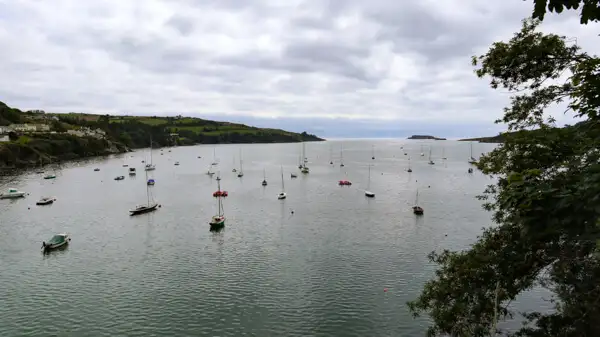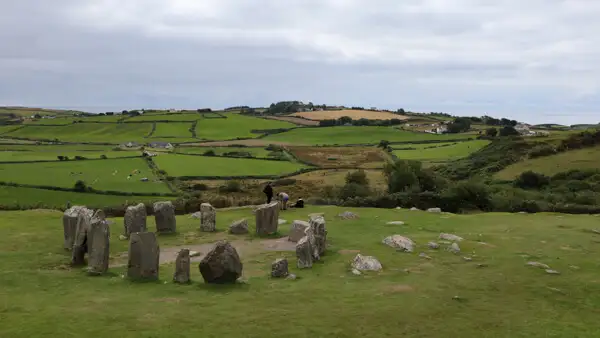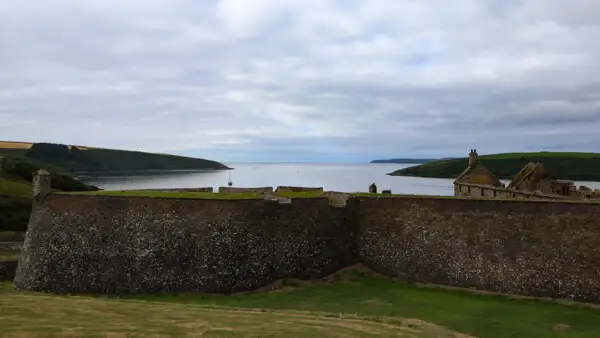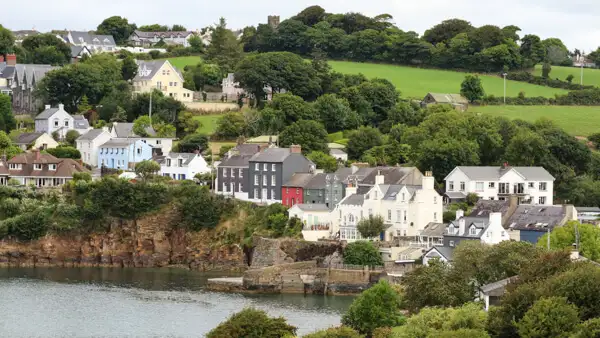We are nearing the end of the virtual journey around the Wild Atlantic Way. But it could also be the beginning, because you can of course also drive the WAW from south to north!
The southern coast of the WAW also has its beautiful sides…
Page Contents (click line to jump the text)

Toe Head and the Knockdrum Stone Fort
From Baltimore you drive via Loughine to Toe Head. The small road is nice to drive and – yes I repeat myself – the coast is beautiful!
Via Castelhavn Cross you continue to Townshend. There you follow the small R596 a bit to the north and soon you will see the small entrance to Stone Fort on your left. You have to park there and reach the fort in a few minutes via a small footpath.
The well-preserved ring fort was archaeologically investigated in the 1930s and later restored. Foundations of a rectangular building can be found inside. The wooden structures where the local clan once lived have long since crumbled.
But the 2-metre-thick circular protective wall, nearly 30 metres in diameter, has survived the millennia very well.

Glandore and the Drombeg Stone Circle
It’s onto the N71 for a short stretch, then immediately right again to Glandore. The tiny harbour nestles in the far corner of the bay.
Follow the R597 a little further and look out for the sign to Drombeg Stone Circle.
The thousands of years old stone circle lies on a hill and is fantastically preserved. It is easy to imagine that Celtic druids once celebrated their ancient rituals here.
Ireland is truly the land of myths and stories and a country where you can experience a lot of history.
You can continue cruising along the small coastal roads or take the N71 to Kinsale, depending on how much time you have.

Kinsale and the Charles Fort
In Kinsale you will reach the southern starting point or the destination of the Wild Atlantic Way. The pretty harbour town is quite touristy, but also offers good accommodation, pubs and restaurants for a cosy evening.
In front of the wide bay of the harbour, the defiant Charles Fort spreads out on the shore. The fort was built in the 17th century and its cannon-laden bastion protected the harbour, which was of strategic importance for trade and the navy.

Summary of the Wild Atlantic Way
Your motorbike tour along the Wild Atlantic Way stretches over 2500 kilometres from the far north of Ireland to Kinsale in the south.
Over 2500 kilometres, many hills, rocks, mountains, sandy beaches, lighthouses, castles, monasteries, cottages, colourful towns, romantic bays and wild cliffs, fishing boats and sailing ships, seagulls and sheep – a lot of sheep – pass you by – or rather: you pass them by.
In the 10 episodes of this short series of articles on the Wild Atlantic Way, you already got a first impression of what to expect in Ireland.
What comes next? Experience it for yourself!
Take a look at our page with our rental motorbikes:
See you in Ireland!
More interesting articles for you
IRELAND’S WILD ATLANTIC WAY – PART 1 – AN INTRODUCTION TO THE WORLD’S LONGEST COASTAL ROAD
THE MOST BEAUTIFUL CASTLES AND PALACES ON THE IRISH ISLAND – 35 TIPS FOR YOUR ROUND TRIP
VIKINGS – A TOUR IN THE FOOTSTEPS OF THE HIT SERIES – AND THE VIKING HERITAGE OF IRELAND
22 GREAT MOUNTAIN ROUTES AND PASSES FOR YOUR ROADTRIP AROUND IRELAND
Photo credits Cover photo: Bay and harbour of Kinsale, photo by Ulrich Knüppel-Gertberg ( www.ireland-insider.com, www.irland-insider.de).